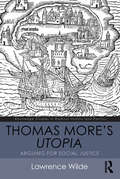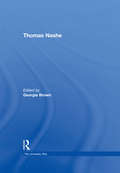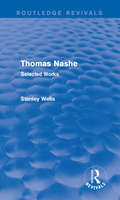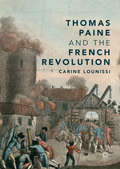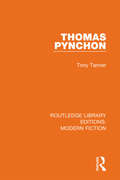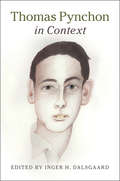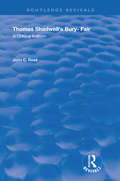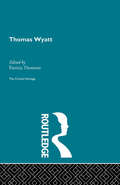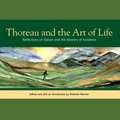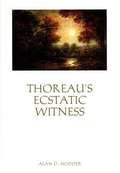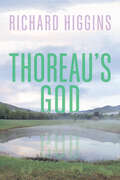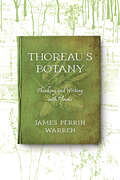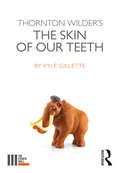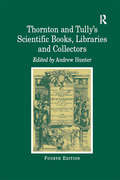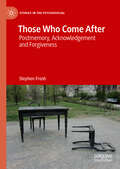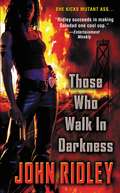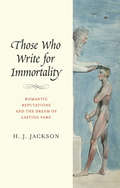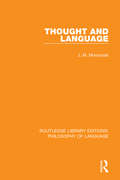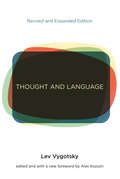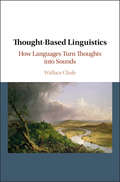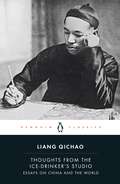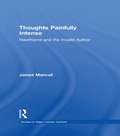- Table View
- List View
Thomas More's Utopia: Arguing for Social Justice (Routledge Studies in Radical History and Politics)
by Lawrence WildeThe 500th anniversary of the first publication of Thomas More’s Utopia invites a reappraisal of its significance, not just as an ironic and playful fiction, but as a serious contribution to social and political thought. More delivers a searing critique of the injustices of his time and imagines a radical alternative based on common ownership and representative government. In this new interpretation, Wilde surveys the context from which Utopia emerged and analyses its key themes – politics, economics, social relations, crime and punishment, war and religion. Although the society of the Utopians is created as a remedy to the ailments of the old world, there are restrictions on individual freedom which reflect More’s suspicion of human nature’s innate fragility. Wilde argues that this should not detract from the power of the book in challenging the root causes of inequality and oppression. The true legacy of Utopia lies in its plea for social justice in the face of a world driven by greed and the lust for power. A compelling case is made for the continued relevance of this masterpiece, a legacy that should not be diminished by attempts to discredit More’s character, which are dealt with here in the epilogue. Offering a new perspective on this important historical text, this book is essential reading for students and scholars working in radical politics, the history of social thought and literature, as well as anyone interested in learning more about this fascinating work.
Thomas Nashe (The University Wits)
by Georgia BrownThe current surge of interest in the Elizabethan poet, dramatist, prose-writer and critic, Thomas Nashe, follows years of neglect or undisguised hostility. Yet, as early allusions testify, Nashe was a name which imposed itself on contemporary culture. Nashe annoyed and even disturbed his contemporaries, but they certainly paid attention to him because he pioneered new approaches to writing, and indeed to living, and because he was an astute critic. The essays in this volume have been chosen for the skill with which they present diverse approaches to key issues in Nashe. All Nashe's texts are covered, as are his relationships with contemporaries, like Shakespeare. The introduction analyses different approaches, locating them in the history of Nashe criticism, and suggests areas for future research. It argues that Nashe's importance to Renaissance studies lies in his anomalousness, as he forces us to rethink the Renaissance. He makes the Renaissance unfamiliar again, and pushes criticism out of its comfort zone.
Thomas Nashe: Selected Works (Routledge Revivals)
by Stanley WellsThis book, first published in 1964, is devoted to Thomas Nashe. Shakespeare’s plays have many apparent echoes of his matter and style; he was one of the most adventurous and successful of those who tried to explore the possibilities of the language and to embellish it was an eloquence both learned and popular. Moreover, he is a conscientious and delighted portrayer of the London of his time; he combines the interests of a Mayhew with the exuberance of a Dylan Thomas. This book will be of interest to students of literature.
Thomas Paine and the French Revolution
by Carine LounissiThis book explores Thomas Paine's French decade, from the publication of the first part of Rights of Man in the spring of 1791 to his return trip to the United States in the fall of 1802. It examines Paine's multifarious activities during this period as a thinker, writer, member of the French Convention, lobbyist, adviser to French governments, officious diplomat and propagandist. Using previously neglected sources and archival material, Carine Lounissi demonstrates both how his republicanism was challenged, bolstered and altered by this French experience, and how his positions at key moments of the history of the French experiment forced major participants in the Revolution to defend or question the kind of regime or of republic they wished to set up. As a member of the Lafayette circle when writing the manuscript of Rights of Man, of the Girondin constellation in the Convention, one of the few democrats who defended universal suffrage after Thermidor, and as a member of the Constitutional Circle which promoted a kind of republic which did not match his ideas, Paine baffled his contemporaries and still puzzles the present-day scholar. This book intends to offer a new perspective on Paine, and on how this major agent of revolutions contributed to the debate on the French Revolution both in France and outside France.
Thomas Pynchon (Routledge Library Editions: Modern Fiction #23)
by Tony TannerThomas Pynchon is now recognized as a major contemporary novelist and perhaps the most important American writer since Melville. His work is both richly imaginative and amazingly erudite and can be compared, in its complexity, linguistic playfulness and experimentation and wealth of allusion, to the work of James Joyce. Aspects of history, psychology, technology and science, cultural and political movements, problems of identity and society and the status and function of fiction and narrative in the modern world are all dramatized with extraordinary wit and power. Tony Tanner provides a brief, comprehensive introduction to his work. Against the background of Pynchon the man, this book, originally published in 1982, examines in detail his early short stories (some of which are not easily accessible) and offers a guide to the reading of his novels, V., The Crying of Lot 49 and Gravity’s Rainbow. Many of Pynchon’s recurrent themes, from entropy and information theory to his interest in the operations and divisions of power in the world since the Second World War, are considered. Finally, Tony Tanner places Pynchon and his work in a broader cultural and literary context.
Thomas Pynchon and American Counterculture
by Joanna FreerThomas Pynchon and the American Counterculture employs the revolutionary sixties as a lens through which to view the anarchist politics of Pynchon's novels. Joanna Freer identifies and elucidates Pynchon's commentaries on such groups as the Beats, the New Left and the Black Panther Party and on such movements as the psychedelic movement and the women's movement, drawing out points of critique to build a picture of a complex countercultural sensibility at work in Pynchon's fiction. In emphasising the subtleties of Pynchon's responses to counterculture, Freer clarifies his importance as an intellectually rigorous political philosopher. She further suggests that, like the graffiti in Gravity's Rainbow, Pynchon creates texts that are 'revealed in order to be thought about, expanded on, translated into action by the people', his early attraction to core countercultural values growing into a conscious, politically motivated writing project that reaches its most mature expression in Against the Day.
Thomas Pynchon in Context (Literature in Context)
by Inger H. DalsgaardThomas Pynchon in Context guides students, scholars and other readers through the global scope and prolific imagination of Pynchon's challenging, canonical work, providing the most up-to-date and authoritative scholarly analyses of his writing. This book is divided into three parts. The first, 'Times and Places', sets out the history and geographical contexts both for the setting of Pynchon's novels and his own life. The second, 'Culture, Politics and Society', examines twenty important and recurring themes which most clearly define Pynchon's writing - ranging from ideas in philosophy and the sciences to humor and pop culture. The final part, 'Approaches and Readings', outlines and assesses ways to read and understand Pynchon. Consisting of Forty-four essays written by some of the world's leading scholars, this volume outlines the most important contexts for understanding Pynchon's writing and helps readers interpret and reference his literary work.
Thomas Shadwell's Bury-Fair: A Critical Edition (Routledge Revivals)
by John C. RossFirst published in 1995, Ross provides a critical edition of Thomas Shadwell’s Bury Fair.
Thomas Wyatt: The Critical Heritage (Critical Heritage Ser.)
by Patricia ThomsonFirst Published in 1995. Routledge is an imprint of Taylor & Francis, an informa company.
Thoreau and the Art of Life: Reflections on Nature and the Mystery of Existence
by Henry David Thoreau Illustrator Roderick Maciver EditorThoreau and the Art of Life collects eloquent passages from the writings of the seminal author and philosopher. Drawn mainly from his journals, the short excerpts provide fascinating insight into his thought processes by presenting his raw, unedited feelings about the things that meant the most to him. The book reflects Thoreau's deep beliefs and ideas about nature, relationships, creativity, spirituality, ageing, simplicity, and wisdom. By eloquently expressing his thoughts about life and what gives it value, he leads the reader to a closer examination of life. Thoreau's work asks us to live our own truths with joy and discipline and to recognize that we live in a universe of extraordinary beauty, mystery, and wonder. An avid reader of Thoreau, editor and illustrator Roderick MacIver organized the passages by themes. The book includes a chronology and brief biography. Thoreau's words of wisdom combined with MacIver's vivid illustrations of the American landscape will resonate with nature enthusiasts and a broad range of readers interested in art, environmentalism, literature, and philosophy.
Thoreau's Axe: Distraction and Discipline in American Culture
by Caleb SmithHow nineteenth-century “disciplines of attention” anticipated the contemporary concern with mindfulness and being “spiritual but not religious”Today, we’re driven to distraction, our attention overwhelmed by the many demands upon it—most of which emanate from our beeping and blinking digital devices. This may seem like a decidedly twenty-first-century problem, but, as Caleb Smith shows in this elegantly written, meditative work, distraction was also a serious concern in American culture two centuries ago. In Thoreau’s Axe, Smith explores the strange, beautiful archives of the nineteenth-century attention revival—from a Protestant minister’s warning against frivolous thoughts to Thoreau’s reflections on wakefulness at Walden Pond. Smith examines how Americans came to embrace attention, mindfulness, and other ways of being “spiritual but not religious,” and how older Christian ideas about temptation and spiritual devotion endure in our modern ideas about distraction and attention.Smith explains that nineteenth-century worries over attention developed in response to what were seen as the damaging mental effects of new technologies and economic systems. A “wandering mind,” once diagnosed, was in need of therapy or rehabilitation. Modeling his text after nineteenth-century books of devotion, Smith offers close readings of twenty-eight short passages about attention. Considering social reformers who designed moral training for the masses, religious leaders who organized Christian revivals, and spiritual seekers like Thoreau who experimented with regimens of simplified living and transcendental mysticism, Smith shows how disciplines of attention became the spiritual exercises of a distracted age.
Thoreau's Ecstatic Witness
by Alan D. Hodder"When Henry David Thoreau died in 1862, friends and admirers remembered him as an eccentric man whose outer life was continuously fed by deeper spiritual currents. But scholars have since focused almost exclusively on Thoreau's literary, political, and scientific contributions. This book offers the first in-depth study of Thoreau's religious thought and experience. In it Alan D. Hodder recovers the lost spiritual dimension of the writer's life, revealing a deeply religious man who, despite his rejection of organized religion, possessed a rich inner life, characterized by a sort of personal, experiential, nature-centered, and eclectic spirituality that finds wider expression in America today. " "At the heart of Thoreau's life were episodes of exhilaration in nature that he commonly referred to as his ecstasies. Hodder explores these representations of ecstasy throughout Thoreau's writings - from the riverside reflections of his first book through Walden and the later journals, when he conceived his journal writing as a spiritual discipline in itself and a kind of forum in which to cultivate experiences of contemplative non-attachment. In doing so, Hodder restores to our understanding the deeper spiritual dimension of Thoreau's life to which his writings everywhere bear witness. "--BOOK JACKET. Title Summary field provided by Blackwell North America, Inc. All Rights Reserved
Thoreau's God
by Richard HigginsMeditative reflections on the great spiritual seeker’s deeply felt experience of the divine. Henry David Thoreau’s spiritual life is a riddle. Thoreau’s passionate critique of formal religion is matched only by his rapturous descriptions of encounters with the divine in nature. He fled the church only to pursue a deeper communion with a presence he felt at the heart of the universe. He called this illimitable presence many names, but he often called it God. In Thoreau’s God, Richard Higgins invites seekers—religious or otherwise—to walk with the great Transcendentalist through a series of meditations on his spiritual life. Thoreau offers us no creed, but his writings encourage reflection on how to live, what to notice, and what to love. Though his quest was deeply personal, Thoreau devoted his life to communicating his experience of an infinite, wild, life-giving God. By recovering this vital thread in Thoreau’s life and work, Thoreau’s God opens the door to a new understanding of an original voice in American religion that speaks to spiritual seekers today.
Thoreau’s Botany: Thinking and Writing with Plants (Under the Sign of Nature)
by James Perrin WarrenThoreau’s last years have been the subject of debate for decades, but only recently have scholars and critics begun to appreciate the posthumous publications, unfinished manuscripts, and Journal entries that occupied the writer after Walden (1854). Until now, no critical reader has delved deeply enough into botany to see how Thoreau’s plant studies impact his thinking and writing. Thoreau’s Botany moves beyond general literary appreciation for the botanical works to apply Thoreau’s extensive studies of botany—from 1850 to his death in 1862—to readings of his published and unpublished works in fresh, interdisciplinary ways. Bringing together critical plant studies, ecocriticism, and environmental humanities, James Perrin Warren argues that Thoreau’s botanical excursions establish a meeting ground of science and the humanities that is only now ready to be recognized by readers of American literature and environmental literature.
Thornton Wilder's The Skin of our Teeth (The Fourth Wall)
by Kyle Gillette"Ladies and gentlemen, I’m not going to play this particular scene tonight." - Sabina Thornton Wilder’s The Skin of Our Teeth (1942) telescopes an audacious stretch of western history and mythology into a family drama, showing how the course of human events operates like theatre itself: constantly mutable, vanishing and beginning again. Kyle Gillette explores Wilder’s extraordinary play in three parts. Part I unpacks the play’s singular yet deeply interconnected place in theatre history, comparing its metatheatrics to those of Stein, Pirandello and Brecht, and finding its anticipation of American fantasias in the works of Vogel and Kushner. Part II turns to the play’s many historic and mythic sources, and examines its concentration of western progress and power into the model of a white, American upper-middle-class nuclear family. Part III takes a longer view, tangling with the play’s philosophical stakes. Gillette magnifies the play’s ideas and connections, teasing out historical, theoretical and philosophical questions on behalf of readers, scholars and audience members alike.
Thornton and Tully's Scientific Books, Libraries and Collectors: A Study of Bibliography and the Book Trade in Relation to the History of Science
by Andrew HunterIn the 25 years since the last edition of Thornton and Tully’s Scientific Books, Libraries and Collectors was published, scientific publishing has mushroomed, developed new forms, and the academic discipline and popular appreciation of the history of science have grown apace. This fourth edition discusses these changes and ponders the implications of developments in publishing at the end of the twentieth century, while concentrating its gaze upon the dissemination of scientific ideas and knowledge from Antiquity to the industrial age. In this shift of focus it departs from previous editions, and for the first time a chapter on Islamic science is included. Recurrent themes in several of the ten essays in the present volume are the definition of ’science’ itself, and its transmutation by publishing media and the social context. Two essays on the collecting of scientific books provide a counterpoint, and the book is grounded on a rigorous chapter on bibliographies. The timely publication of Scientific Books, Libraries and Collectors comes at the coincidence of the advent of electronic publishing and the millennium, a dramatic moment at which to take stock.
Those Who Come After: Postmemory, Acknowledgement and Forgiveness (Studies in the Psychosocial)
by Stephen FroshThis book explores the legacies of suffering in relation to ‘those who come after’ – the descendants of victims, survivors and perpetrators of traumatic events. It draws on recent discussions of ‘postmemory’ and ‘haunting’ that are concerned mainly with the transgenerational impact of personal and social trauma. It examines how we are connected to past events for which we have no direct responsibility yet in which we might in some way be ‘implicated’ and it asks how we might attain a position of active witnessing that helps resolve the suffering of others. Those Who Come After includes vivid accounts of witnessing from a variety of perspectives, ranging from Biblical and Jewish stories to contemporary art and music. The book draws on psychosocial studies and psychoanalysis to help make sense of this material and to develop an understanding of acknowledgment and responsibility that is both ethical and emancipatory. Those Who Come After will be of great interest to readers in psychosocial studies and psychoanalysis and to all who are concerned with the question of how to put past suffering to rest.
Those Who Walk in Darkness
by John RidleyIn the near future, the world has become home to certain people with amazing genetic structures-giving them powers that make them frighteningly superior to normal humans.
Those Who Write for Immortality
by H. J. JacksonGreat writers of the past whose works we still read and love will be read forever. They will survive the test of time. We remember authors of true genius because their writings are simply the best. Or . . . might there be other reasons that account for an author's literary fate? This original book takes a fresh look at our beliefs about literary fame by examining how it actually comes about. H. J. Jackson wrestles with entrenched notions about recognizing genius and the test of time by comparing the reputations of a dozen writers of the Romantic period--some famous, some forgotten. Why are we still reading Jane Austen but not Mary Brunton, when readers in their own day sometimes couldn't tell their works apart? Why Keats and not Barry Cornwall, who came from the same circle of writers and had the same mentor? Why not that mentor, Leigh Hunt, himself? Jackson offers new and unorthodox accounts of the coming-to-fame of some of Britain's most revered authors and compares their reputations and afterlives with those of their contemporary rivals. What she discovers about trends, champions, institutional power, and writers' conscious efforts to position themselves for posterity casts fresh light on the actual processes that lead to literary fame.
Those Who from Afar Look Like Flies: An Anthology of Italian Poetry from Pasolini to the Present, Tome 1, 1956-1975
by Luigi Ballerini Giuseppe CavatortaThose Who from Afar Look Like Flies is an anthology of poems and essays that aims to provide an organic profile of the evolution of Italian poetry after World War II. Beginning with the birth of Officina and Il Verri, and culminating with the crisis of the mid-seventies, this tome features works by such poets as Pasolini, Pagliarani, Rosselli, Sanguineti and Zanzotto, as well as such forerunners as Villa and Cacciatore. Each section of this anthology, organized chronologically, is preceded by an introductory note and documents every stylistic or substantial change in the poetics of a group or individual. For each poet, critic, and translator a short biography and bibliography is also provided.
Thought and Language
by J. M. MoravcsikOriginally published in 1990, this book centres on a certain way of surveying a variety of theories of language, and on outlining a new proposal of meaning within the framework set by the survey. One of the key features of both survey and proposal is the insistence on the need to locate theories of language within a large framework that includes questions about the nature of thought and about general ontological questions as well. The book deals in an interconnected way with both very general and specific issues. At one end of this spectrum there are discussions of the contrast between realist and nominalist ontologies, while at the other are analyses of specific lexical items of English.
Thought and Language, revised and expanded edition
by Lev S. VygotskyA new edition of a foundational work of cognitive science that outlines a theory of the development of specifically human higher mental functions.Since it was introduced to the English-speaking world in 1962, Lev Vygotsky's Thought and Language has become recognized as a classic foundational work of cognitive science. Its 1962 English translation must certainly be considered one of the most important and influential books ever published by the MIT Press. In this highly original exploration of human mental development, Vygotsky analyzes the relationship between words and consciousness, arguing that speech is social in its origins and that only as children develop does it become internalized verbal thought.In 1986, the MIT Press published a new edition of the original translation by Eugenia Hanfmann and Gertrude Vakar, edited by Vygotsky scholar Alex Kozulin, that restored the work's complete text and added materials to help readers better understand Vygotsky's thought. Kozulin also contributed an introductory essay that offered new insight into Vygotsky's life, intellectual milieu, and research methods. This expanded edition offers Vygotsky's text, Kozulin's essay, a subject index, and a new foreword by Kozulin that maps the ever-growing influence of Vygotsky's ideas.
Thought-Based Linguistics: How Languages Turn Thoughts into Sounds
by Wallace ChafeThe extent to which language is inseparable from thought has long been a major subject of debate across linguistics, psychology, philosophy, and other disciplines. In this study, Wallace Chafe presents a thought-based theory of language that goes beyond traditional views that semantics, syntax, and sounds are sufficient to account for language design. Language begins with thoughts in the mind of a speaker and ends by affecting thoughts in the mind of a listener. This obvious observation is seldom incorporated in descriptions of language design for two major reasons. First, the role of thought is usually usurped by semantics. But semantic structures are imposed on thought by languages and differ from one language to another. Second, thought does not lend itself to familiar methods of linguistic analysis. Chafe suggests ways of describing thoughts, traces the path languages follow from thoughts to sounds, and explores ways in which thoughts are oriented in time, memory, imagination, reality, and emotions.
Thoughts From the Ice-Drinker's Studio: Essays on China and the World
by Liang Qichao'China's first iconic modern intellectual. His lucid and prolific writings, touching on all major concerns in his own time and anticipating many in the future, inspired several generations of thinkers' Pankaj Mishra'A country does not become corrupt and weak overnight. Rather, we are now reaping the evil harvest of what previous generations sowed.'The power, anger and fluency of Liang Qichao's writings make him one of the towering figures in modern Chinese literature. He saw his great, almost unmanageable task as an attempt to write China into the new era - to provide an ancient country, devastated by civil war and foreign predators, with the intellectual equipment to renew itself.Liang said that he wrote from an 'ice-drinker's studio', implying that underneath his dispassionate, disabused and rational tone lay an ardour and passion which only ice could cool. China could only recover through a clear-sighted, informed understanding of its enemies - and by engaging in a thorough-going self-critique. Liang did not propose aping the West but taking only what China needed to 'renew the people' and create 'new citizens'. Then China would be able to expel its invaders, reform its society and become a great power once more.This selection of pieces shows Liang's extraordinary range and the burning sense of mission which drove him on, attempting to galvanize and refresh an entire nation. Blending together Confucianism, Buddhism and the Western Enlightenment, Liang's ideas about nation, democracy, and morality had a profound impact on Chinese visions of the political order, though the China that eventually emerged from the further disasters of the 1930s and 1940s would be a very different one.
Thoughts Painfully Intense: Hawthorne and the Invalid Author (Studies in Major Literary Authors)
by James MancallFirst Published in 2002. Routledge is an imprint of Taylor & Francis, an informa company.
